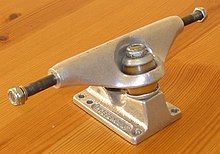Skateboard Parts
A skateboard is made up of both movable and immovable parts to help you move forward or backward plus steering left and right. Plus it is the easiest way to move of any sports equipment, put one foot on the board (called a deck) and push with the other foot.
Board parts
- Hardware: Nuts, bolts, and screws that hold the trucks, bushings, and base plate onto the board.
- Board: Also known as the Deck, this is the main part of a skateboard, the portion that is used to skate on. Boards are typically made of 7 or 9 plies of maple, birch, or some other wood, laminated together and shaped into numerous board shapes.
- Grip Tape: sandpaper affixed to the top of the board with adhesive. Grip tape provides traction so movement from the feet is transferred to the board.
- Nose: the front of the skateboard.
- Tail: the rear of the skateboard, usually measured from the rear truck bolts to the end of the board. (usually curved up at about a 10 degree angle from the rest of the deck)
Truck parts
- Trucks: The truck is the collective name for the front and rear axle assemblies that connect the wheels to the deck and provide the turning capabilities for the board. The major components of the truck includes the base plate, axle, and the hanger. Also to sustain the weight bearing of the load on top.
- Axle: The axle is a metal rod which runs through the hanger and extends from it on either side. Wheels are inserted on either end and secured with the axle nut.
- Wheels: usually made of polyurethane and sized between 39 and 70 millimeters in diameter; their hardness is measured by durometer, a number ranging from 0 to 100—soft wheels have a durometer of about 85, hard wheels have a durometer of 98 or higher .63 mm wheels are usually more for longboards which go significantly faster.
- Wheelbase: the distance between the front and back wheels, measured between the two sets of innermost truck holes. A longer wheelbase adds stability by increasing its moments of inertia and reducing the pitch and/or yaw induced by wheel displacement.
- Kingpin: Is a partially threaded pin placed through the base plate and truck and secured with the kingpin nut. The Kingpin holds the bushings, truck hanger, and base plate together.
- Bushing: Bushings are donut-shaped polyurethane pieces that are inserted onto the kingpin of a truck. There are two bushings per truck, one above and one below where the hanger fits onto the kingpin. Adjusting the kingpin nut to tighten or loosen the bushings will adjust the turning radius and response of the truck itself. Tighter bushings mean stiffer trucks and less chance of wheel bite, while loose bushings make for easier turning but a greater chance of wheel bite.
- Pivot Cup: A raised and hollowed receptacle on the base plate opposite the kingpin which holds the pivot bushing.
- Pivot Bushing: A plastic cup-shaped piece which rests in the pivot cup of the base plate and supports the truck’s hanger at the pivot point allowing the truck to pivot smoothly. The pivot bushing prevents frictional contact between the truck and the base plate and provides a cushioned pivot point.
Bearings
Animation of a ball bearing. Red dots show direction of rotation. The two concentric circles that the ball bearings ride on are called races.
- Bearings: In skateboarding bearings allow for the smooth turning of a wheel on its axle. Bearings consist of 6, 7, or 8 balls enclosed in races between two shields encased in a disc-like body. Bearings can be measured by an ABEC rating. Skateboard bearings typically come in sets of eight and are inserted into both sides of the wheel; two bearings for each of the four wheels.
- Crown: Crowns are also called retainers or cages and are usually made of Delrin. Crowns hold and separate the individual balls in a bearing.
- Bearing Shield: Are the two walls that hold the ball bearings and Delrin crowns from falling out. The bearing shield plays an important role as well in keeping dirt from getting into the bearing and slowing it down. Some bearings have only one shield and can be taken apart for maintenance.
- C Clip: The C clip is a mechanism for locking bearing shields in place. It is essentially a thin C-shaped wire that fits tightly into a groove around the outside perimeter of the bearing shield to hold it in place against the bearing casing. Not all bearings have a C clip, but those that do can usually be taken apart for cleaning and maintenance.
- Casing: The casing is the body of the bearing. It holds the ball bearings, crown, and shield in place.


 A skateboard truck
A skateboard truck



